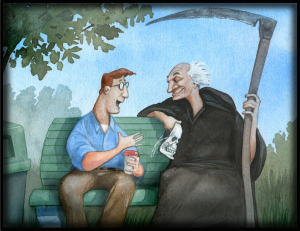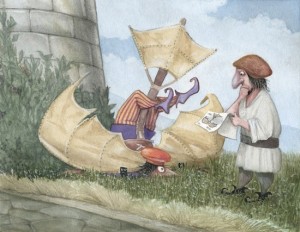Failure Is a Possibility: Facing the Hard Truths of Life and Business
Eran Dror is an interesting man. You might call him a polymath: after studying history, philosophy, and film in college, he became a tech journalist. Then he moved to the states from Israel and worked in product-related roles at a series of startups.
Dror has also seen some stuff: in 2011, as he turned 30, he found himself single again, working at a startup that wasn’t doing very well. “We were running out of cash really quickly and didn’t know if we were going to be able to raise more money or what was going to happen with it,” he says.
And then, in the middle of it all, he found out his work visa was stuck in bureaucratic limbo. “My lawyer let me know that I had to leave the country right away,” he says.
Cue a 3-month forced exile from the U.S., which Dror spent sleeping on a couch in his startup’s Warsaw office.
“Basically, [I was] completely disconnected from the life I had known and built for myself, not knowing if I would ever be able to come back,” Dror says.
In danger of losing both his job and the life he made for himself in the states, Dror found the uncertainty excruciating — as most of us would.
But over time, a silver lining appeared. “I realize this is not Greek tragedy stuff, but in this sort of difficult position, I found peace,” Dror says. “I discovered that I wasn’t actually doing so badly. I loved the people I was working with in Poland. [Warsaw] was a brand new city I didn’t know anything about, and I started exploring it. I started relaxing into [my situation].”
Eventually, everything turned out fine: Dror’s visa went through, he returned to the states, and the company he worked with was sold off, with some benefit for him.
“It was just a stupid three-month delay, and I went back to my life,” Dror says. “Everything went fine from that point on.”
As Dror reflect on his crisis time in Warsaw, he began to wonder why he spent three months being miserable when everything would, ultimately, be okay.
“Did I actually have to suffer the way I suffered for 3 months? I was just imagining the worst-case scenario, but it never actually came true,” Dror says. “So why was I feeling that the worst case was coming true every single day of those 3 months, when it wasn’t going to?”
Dror realized that his discomfort with uncertainty was really a perspective that he had — a perspective that he didn’t have to have. If he had only accepted his situation sooner, maybe he wouldn’t have suffered so much.
“I started to kind of dig into what other perspectives – what other tough things — would actually liberate us if we could just accept them,” Dror says.
Dror’s exploration resulted in “The Book of Hard Truths,” a book he describes as a 16-item “checklist for the soul, sort of, that helps you kind of locate where you need to put more work.” Among the hard truths to book addresses are “you’re going to do,” “you’ll never find yourself,” and “you’re not special.” It’s not light reading — but it is compelling reading, thanks in no small part to the gorgeous illustrations (done by painter and illustrator John Cox ) that accompany each hard truth, one of which sits atop this very page.
It also helps that Dror guides readers through each hard truth, detailing how acceptance can be liberating and offering additional resources to aid in the process of reconciliation with life’s crueler realities.
Curious about this strange and fascinating book, I Skyped Dror to find out why he wanted to drop such a bummer on the world and what professionals and job seekers could get out of it (this is, after all, an employment-centric website). What follows is a transcript of our call, with minimal editing for style and clarity.
Recruiter.com:Why did you write “The Book of Hard Truths”? What do you hope people get from the book — what do you want people to walk away knowing or feeling?
Eran Dror: [I had a theory] when I was writing this book, and it was borne out by the way people reacted to it. My theory was that everyone is stuck along a different path; everyone is stuck with a different one of these hard truths. I wanted to create a checklist for all of the hard truths that I know and that I could find in the literature, and I thought everybody would experience some sort of pang of pain somewhere along the way when browsing this book. They’re going to recognize that they haven’t accepted one of these truths, and because of the structure of the book — it’s about acceptance — they’re going to start thinking about it. There’s going to be a process that starts. Really what I was hoping to do was spark different types of processes with different types of people, depending on what they personally have not yet processed.
And that really happens! Every time I give this to someone I know — and I’ve gotten similar feedback from the readers I don’t know, too — they immediately identify the one or two that they personally haven’t dealt with yet, and they get this sort of painful look in their eyes as they browse, like, ‘Oh, yes, this is the one.’ And then they say that they can’t quite shake it. The book stays with them, and they realize this is something they have to work with. I’ve had friends who kind of later moved on to read a book [about the particular truth], to continue thinking about it and processing it.
It’s been pretty rewarding, because really, the takeaway for every person is different, but that’s exactly the way it was designed.
RC: Are any of the hard truths especially salient to you? Do you notice ones that people seem to respond to more often than the others?
ED: Yes, definitely. I’m surrounded by productivity nuts — I’m one myself — and No. 6, which is ‘You can’t do it all,’ really strikes a lot of people. A lot of people stop on that one and say, ‘Oh, that’s one I definitely haven’t accepted yet.’ They’re trying to do it all. They’re trying to do too much. They can’t say no to projects. We’re all sort of in that state: we haven’t accepted that there’s a very limited number of things that we get to do in this life.
I think this one is definitely an important one for people on a career track as well.
RC: I’m glad you mentioned careers, because it leads to my next question. So we’ve touched on productivity, but how else do you see people using this book in their professional lives? Can they get anything out of it that is directly applicable to, say, working in an office or being on a job hunt?
ED: I think the book is especially pertinent to anyone in a creative field, and that includes entrepreneurship, that includes running a business — any place where you’re in charge of what you do. [These jobs] really necessitate priorities, understanding the limits of time, being in the moment and making wise decisions about that, and understanding the limits of your power.
You don’t have to necessarily think about these things when you’re working for a company that has everything figured out for you and you just need to do what you’re told, but even in those companies, if you’re an information worker, you may need to make decisions about your career or your personal life. So I think there’s a lot of it that is pertinent: the limits of your control, the limits of your knowledge, etc. I think people who know how much they don’t know tend to do really well, because they remain curious and they remain open, and open-mindedness is again and again something that has been correlated with success.
The part about failure is especially important, too. Truth No. 13, “failure is an option,” reminds us that we have to accept the risk of failure in order to succeed at anything. Being okay with trying something that is not 100 percent guaranteed to work is really the key for creating anything great in this world.
All images by John Cox, courtesy of Eran Dror



